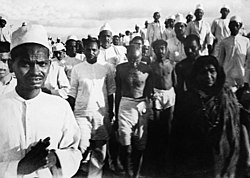


Nonviolent resistance, or nonviolent action, sometimes called civil resistance, is the practice of achieving goals such as social change through symbolic protests, civil disobedience, economic or political noncooperation, satyagraha, constructive program, or other methods, while refraining from violence and the threat of violence.[1] This type of action highlights the desires of an individual or group that feels that something needs to change to improve the current condition of the resisting person or group.
Mahatma Gandhi is the most popular figure related to this type of protest; United Nations celebrates Gandhi's birthday, October 2, as the International Day of Non-Violence. Other prominent advocates include Abdul Ghaffar Khan, Henry David Thoreau, Etienne de la Boétie, Charles Stewart Parnell, Te Whiti o Rongomai, Tohu Kākahi, Leo Tolstoy, Alice Paul, Martin Luther King Jr., Daniel Berrigan, Philip Berrigan, James Bevel, Václav Havel, Andrei Sakharov, Lech Wałęsa, Gene Sharp, Nelson Mandela, Jose Rizal, and many others. From 1966 to 1999, nonviolent civic resistance played a critical role in fifty of sixty-seven transitions from authoritarianism.[2]
The "Singing revolution" (1989–1991) in Estonia, Latvia and Lithuania, led to the three Baltic countries' restoration of independence from the Soviet Union in 1991 [citation needed]. Recently, nonviolent resistance has led to the Rose Revolution in Georgia. Research shows that nonviolent campaigns diffuse spatially. Information on nonviolent resistance in one country could significantly affect nonviolent activism in other countries.[3][4]
Many movements which promote philosophies of nonviolence or pacifism have pragmatically adopted the methods of nonviolent action as an effective way to achieve social or political goals.[5] They employ nonviolent resistance tactics such as: information warfare, picketing, marches, vigils, leafletting, samizdat, magnitizdat, satyagraha, protest art, protest music and poetry, community education and consciousness raising, lobbying, tax resistance, civil disobedience, boycotts or sanctions, legal/diplomatic wrestling, Underground Railroads, principled refusal of awards/honors, and general strikes.[6] Current nonviolent resistance movements include: the Jeans Revolution in Belarus, the fight of the Cuban dissidents, and internationally the Extinction Rebellion and School Strike for Climate.
Although nonviolent movements can maintain broader public legitimacy by refraining from violence, some segments of society may perceive protest movements as being more violent than they really are when they disagree with the social goals of the movement.[7] A great deal of work has addressed the factors that lead to violent mobilization, but less attention has been paid to understanding why disputes become violent or nonviolent, comparing these two as strategic choices relative to conventional politics.[8]
- ^ Communications, Michelle Nicholasen Weatherhead Center (2019-02-04). "Why nonviolent resistance beats violent force in effecting social, political change". Harvard Gazette. Retrieved 2022-11-15.
- ^ Ackerman, Peter; Duvall, Jack (2001). A Force More Powerful: A Century of Non-violent Conflict. Palgrave.
- ^ Gleditsch, Kristian (2017). "The Diffusion of Nonviolent Campaigns". Journal of Conflict Resolution. 61 (5): 1120–1145. doi:10.1177/0022002715603101. S2CID 142158335.
- ^ RezaeeDaryakenari, Babak; Asadzadehmamaghani, Peyman (2020). "Learning about principles or prospects for success? An experimental analysis of information support for nonviolent resistance". Research & Politics. 7 (2). doi:10.1177/2053168020931693. hdl:1887/136463. S2CID 220323282.
- ^ Merriman, Hardy (2023-05-03). "The Trifecta of Civil Resistance: Unity, Planning, Discipline". The Commons Social Change Library. Retrieved 2024-04-19.
- ^ International Center on Nonviolent Conflict; Beer, Michael (2021-04-16). "Civil Resistance Tactics in the 21st Century: Report and Webinar". The Commons Social Change Library. Retrieved 2024-04-19.
- ^ Hsiao, Yuan; Radnitz, Scott (18 August 2020). "Allies or Agitators? How Partisan Identity Shapes Public Opinion about Violent or Nonviolent Protests". Political Communication. 38 (4): 479–497. doi:10.1080/10584609.2020.1793848. S2CID 225354058.
- ^ Cunningham, K. G. (2013). "Understanding strategic choice: The determinants of civil war and nonviolent campaign in self-determination disputes". Journal of Peace Research. doi:10.1177/0022343313475467.